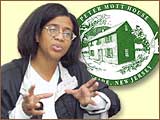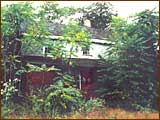THE EMOTIONAL SIDE OF HISTORY
An Interview With Linda Waller

By Hoag Levins ...| ...October 14, 2001

LAWNSIDE, N.J. -- When you've spent the last ten years focused on the blizzard of administrative details involved in physically restoring, registering and maintaining a 157-year-old historic structure, it's

|
| Photo: Hoag Levins. |
|
Linda Waller, President of the Lawnside Historical Society.
|
|
easy to lose sight of the big picture, said Linda Waller.
Ms. Waller and the Lawnside Historical Society of which she is President both reached a watershed this weekend as the Peter Mott House was officially opened as a historic site. The specific reason Waller helped form the Historical Society in 1990 was to save this two-story wood-frame farmhouse that once served as a refuge for runaway slaves moving north along the Underground Railroad.
"When you're involved in something like this for so long, you get a little numb from all the time thinking about, 'Are all the state forms completed?,' 'What about the insurance policy?,' 'Did someone call the contractor about the basement leak?,' 'Who got the messages off the answering machine?' and that kind of thing," she said.
Emotional history
But then something happens to make history emotionally real again. For her, it occurred on one of the
pre-official-opening tours she recently gave.
"It really came home to me. I had a group of children and adults and the adults were so moved by just being inside the rooms. They were saying, 'I have chills just standing here and to think of what went on here.'," said Waller.
"I had not been emotional about this in the past but as I watched the profound impact this building had on them, it made me stop for a minute and take in the full realization of what getting to this farm would have meant to fugitive slaves in the nineteenth century -- individuals who were risking their lives and enduring incredible hardships simply to be free. When you really let yourself plug into that emotion, it just fills you up. And that feeling, that story, is what this house is all about. The experience really pulled me back to why I care about this place."
'Finally over?'
"Now, I've had a number of people say to me, 'Wow, aren't you glad it's finally over?' said Waller. "But I tell them this really is just the beginning of something else."
"Now that the house is essentially completed, we need to be thinking about how to market and promote it, how to display artifacts in it, how to interpret it effectively and how to do the kind of academic research necessary to deepen our understanding of what it all means."
When she's not being a volunteer historic preservation administrator,

|
| Photo: Lawnside Historical Society. |
|
This is how the ramshackle Peter Mott house looked in the late 1980s. Near collapse, it was scheduled to be torn down.
|
|
Waller is the Deputy Director of the Dow Jones Newspaper Fund in Princeton, N.J., a non-profit agency that provides internships and scholarships for students pursuing journalism careers.
Ramshackle farmhouse
As a young girl growing up in Lawnside, she often walked by the ramshackle farmhouse that was the subject of oral history traditions passed down through local families. Prior to 1907, Lawnside, a self-contained black community established in the late eighteenth century, was known as "Free Haven" because it served as a sanctuary for runaway slaves.
By the 1980s, the dilapidated structure off Moore and Gloucester Avenues was the last remaining Lawnside building known to have been involved in that liberation movement -- although many residents, including Waller, didn't realize that.
In 1990, as the mother of a ten-year-old daughter, she became concerned that local Black History Month events were focused too much on persons and events in distant places -- rather than on the unique black history of Lawnside itself.
History all around us
"It was just kind of eating at me," she said. "We were celebrating Black History by talking about people who were abstractions even as black history was all around us here in our own community. In an attempt to do something local, we borrowed these very old clothes from a woman in her 90s and put them on display. We asked Clarence Still to speak because he was not only the official historian of the Still Family but the town as well."
Still is a descendant of Philadelphia Abolitionist leader William Still who, in 1871, wrote the first comprehensive account of the secret smuggling system that had helped escaped slaves find their way to freedom in the northern states and Canada.
"So Clarence Still comes to our gathering," remembered Waller. "And he gets up to speak and says 'I can't let this opportunity go by without telling you all about something that is very important. Everybody in Lawnside ought to be up in arms about it. The Peter Mott House is going to be destroyed.'"
Slated to be wrecked
A developer was constructing houses and was preparing to tear down and replace the Peter Mott house with two townhouses.
"We adjourned to the hallway and my sister and a couple of her friends from school said we ought to form a Lawnside Historical Society and do something about this. We've got to focus on saving that house," said Waller. "My sister turned to me and said 'We're going to have a meeting about this next Thursday and it's going to be at your house." And I said, 'Can I come?' And that's how I got involved."
Clarence Still was the first President of the Lawnside Historical Society and remains the organization's Founding President.
"Mr. Still is the reason any of this happened," Waller said. "He is the person who understood what the house meant and the one who stood up and said, 'Builder, stay that backhoe.'"
After two years of discussions, the builder signed over the deed to the Peter Mott House to the new Historical Society. "We took possession of a collapsing building and a bill for $800 in back taxes," remembered Waller with a wry smile.
And a decade later, they have opened it as a registered historical landmark and public museum.
| 


